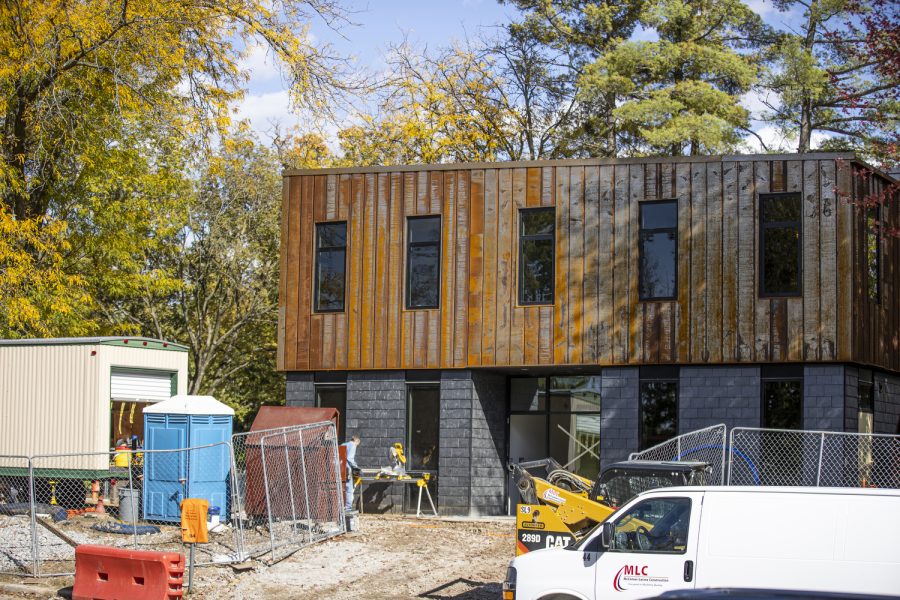UI Nonfiction Writing Program house to open spring 2023
The Nonfiction Writing Program House is the latest addition to the “writers’ neighborhood” on the corner of North Clinton and Church Street and will host classes for both undergraduate and graduate students.
Construction is seen on the University of Iowa Nonfiction Writing Program House in Iowa City on Oct. 12, 2022. The Nonfiction Writing Program was created in 1976.
January 17, 2023
The University of Iowa’s Nonfiction Writing Program will have its own home this semester, as its new building is set to open for students and staff this spring.
Located on the corner of North Clinton and Church streets, construction on the two-story, 3,500 square-foot building began in March 2022 and was moved into over the 2022 winter break.
The new facility will include offices for faculty of the Nonfiction Writing Program, workspaces for graduate teaching assistants, seminars and classrooms, public spaces for gathering, and an open library and lounge that will lead to an outdoor patio.
The UI currently offers several facilities for writing students:
- The English-Philosophy Building, which houses the Writing Center.
- The Dey House, which has the Iowa Writer’s Workshop.
- The Shambaugh House, which is home to the International Writing Program.
- The Magid Center for Writing.
Rod Lehnertz, UI senior vice president for finance and operations and university architect, said the goal of the Nonfiction Writing Program House is to create a stand-alone home for UI nonfiction writing students instead of having them take nonfiction writing classes in the English-Philosophy Building and other campus locations.
Lehnertz said he is “over the moon excited” for the new building because he believes it will help advance notoriety and strengthen the Nonfiction Writing Program.
“It will only solidify their renown and top ranking in the nation and put them into that context with International Writing and the Writers’ Workshop and just strengthen the fabric of the writers’ neighborhood,” he said.
The project is budgeted at $1.75 million and was donated in full by donors and partners, Lehnertz said. Finishing the building in nine months is standard.
“It’s not really a very big project. So, when we look at the amount of dollars expended and sort of the cash flow of construction work, it’s a reasonable amount of time,” Lehnertz said.
The building was constructed by Iowa City general contractor group McComas-Lacina. Damon Keen, McComas-Lacina Construction project manager also said the project was small.
“It’s just an office building with just a little bit of student function down below and some student offices, and I imagine some spaces they can hang out and study as well upstairs and downstairs,” he said.
Keen said some aspects of the construction were typical for the university, but other aspects were more of a residential style. Additionally, Keen said the university opted to use materials that cost less for the building, but it does not take away from the structure.
“It wouldn’t even be noticeable to most people for the use of the building, I mean, it was just certain things were lower budget rather than higher budget material,” he said.
Keen said the first step in the construction process was pulling sidewalks and clearing up the site for the creation of the building’s foundation. The project went relatively smoothly, he said.
RELATED: Carl H. Klaus leaved legacy at the UI, Nonfiction Writing Program
Hannah Bonner, UI second-year creative nonfiction graduate student, said she is excited to see how the building brings the program members together.
“I think one of the benefits of the building will definitely be in viewing our department with more of a sense of community because it will be a building that exclusively houses nonfiction faculty as well as students,” Bonner said.
The bonding and intellectual discourse the building will provide for students is what Bonner looks forward to the most, she said.
“Being in a really supportive and nurturing environment alongside all your peers and mentors will allow those ideas to actually germinate,” she said.
Bonner said she is honored to be among the students who will be a part of university history by inaugurating this new building.
“Having a shared space with the sole purpose of facilitating and participating in conversations as well as being able to talk about the essays, both the written thing and now especially in the 21st century as also a visual medium potentially,” she said.
Bonner said she thinks this building offers the Nonfiction Writing Program a home, and in any environment you need a grounding home space to generate ideas and see them through.
“I’m just incredibly grateful to the faculty for all the tireless work that they’ve done making this a reality,” she said.



